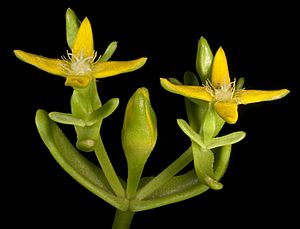Yellow salt star facts for kids
Quick facts for kids Yellow salt star |
|
|---|---|
 |
|
| Gunniopsis intermedia flower | |
| Scientific classification | |
| Genus: |
Gunniopsis
|
| Species: |
intermedia
|
Gunniopsis intermedia, also called the yellow salt star, is a special type of plant. It's a succulent, which means it has thick, fleshy parts that store water. This plant belongs to the iceplant family, called Aizoaceae. You can only find it growing naturally in Australia.
About the Yellow Salt Star
The yellow salt star is a small plant that lives for about one year. It can grow straight up or spread out along the ground. Usually, it reaches a height of 1 to 30 centimeters (about 0.4 to 12 inches). It can also form a small mound up to 0.5 meters (about 1.6 feet) wide.
Its leaves are quite interesting. They are usually 2 to 7 centimeters (about 0.8 to 2.8 inches) long. They are also 2 to 3 centimeters (about 0.8 to 1.2 inches) wide.
Flowers and Blooming Time
This plant produces pretty yellow-white flowers. You can see these flowers blooming during the spring and early summer months. This is usually from September to November in Australia.
Where It Lives
The yellow salt star likes to live in salty places. You can find it growing near salt lakes. It also grows on flat, salty areas in inland parts of Western Australia. These areas include the Wheatbelt and Goldfields-Esperance regions.
It can grow in different types of soil. These include sandy soils, loam (a mix of sand, silt, and clay), or clay soils. It's well-adapted to these challenging environments.
How It Was Discovered
A botanist named Ludwig Diels was the first person to officially describe this plant. He wrote about it in 1904. His description was published in a scientific book called Botanische Jahrbücher für Systematik, Pflanzengeschichte und Pflanzengeographie. This is how the plant got its scientific name.

